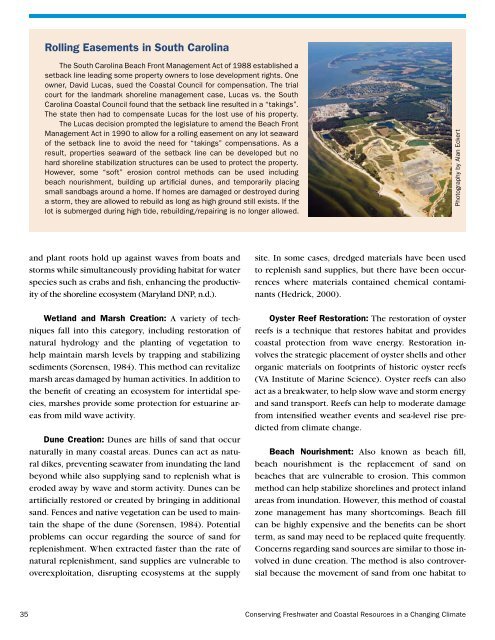Conserving Freshwater and Coastal Resources in a Changing Climate
Conserving Freshwater and Coastal Resources in a Changing Climate
Conserving Freshwater and Coastal Resources in a Changing Climate
Create successful ePaper yourself
Turn your PDF publications into a flip-book with our unique Google optimized e-Paper software.
Roll<strong>in</strong>g Easements <strong>in</strong> South Carol<strong>in</strong>a<br />
The South Carol<strong>in</strong>a Beach Front Management Act of 1988 established a<br />
setback l<strong>in</strong>e lead<strong>in</strong>g some property owners to lose development rights. One<br />
owner, David Lucas, sued the <strong>Coastal</strong> Council for compensation. The trial<br />
court for the l<strong>and</strong>mark shorel<strong>in</strong>e management case, Lucas vs. the South<br />
Carol<strong>in</strong>a <strong>Coastal</strong> Council found that the setback l<strong>in</strong>e resulted <strong>in</strong> a “tak<strong>in</strong>gs”.<br />
The state then had to compensate Lucas for the lost use of his property.<br />
The Lucas decision prompted the legislature to amend the Beach Front<br />
Management Act <strong>in</strong> 1990 to allow for a roll<strong>in</strong>g easement on any lot seaward<br />
of the setback l<strong>in</strong>e to avoid the need for “tak<strong>in</strong>gs” compensations. As a<br />
result, properties seaward of the setback l<strong>in</strong>e can be developed but no<br />
hard shorel<strong>in</strong>e stabilization structures can be used to protect the property.<br />
However, some “soft” erosion control methods can be used <strong>in</strong>clud<strong>in</strong>g<br />
beach nourishment, build<strong>in</strong>g up artificial dunes, <strong>and</strong> temporarily plac<strong>in</strong>g<br />
small s<strong>and</strong>bags around a home. If homes are damaged or destroyed dur<strong>in</strong>g<br />
a storm, they are allowed to rebuild as long as high ground still exists. If the<br />
lot is submerged dur<strong>in</strong>g high tide, rebuild<strong>in</strong>g/repair<strong>in</strong>g is no longer allowed.<br />
Photography by Alan Eckert<br />
<strong>and</strong> plant roots hold up aga<strong>in</strong>st waves from boats <strong>and</strong><br />
storms while simultaneously provid<strong>in</strong>g habitat for water<br />
species such as crabs <strong>and</strong> fish, enhanc<strong>in</strong>g the productivity<br />
of the shorel<strong>in</strong>e ecosystem (Maryl<strong>and</strong> DNP, n.d.).<br />
Wetl<strong>and</strong> <strong>and</strong> Marsh Creation: A variety of techniques<br />
fall <strong>in</strong>to this category, <strong>in</strong>clud<strong>in</strong>g restoration of<br />
natural hydrology <strong>and</strong> the plant<strong>in</strong>g of vegetation to<br />
help ma<strong>in</strong>ta<strong>in</strong> marsh levels by trapp<strong>in</strong>g <strong>and</strong> stabiliz<strong>in</strong>g<br />
sediments (Sorensen, 1984). This method can revitalize<br />
marsh areas damaged by human activities. In addition to<br />
the benefit of creat<strong>in</strong>g an ecosystem for <strong>in</strong>tertidal species,<br />
marshes provide some protection for estuar<strong>in</strong>e areas<br />
from mild wave activity.<br />
Dune Creation: Dunes are hills of s<strong>and</strong> that occur<br />
naturally <strong>in</strong> many coastal areas. Dunes can act as natural<br />
dikes, prevent<strong>in</strong>g seawater from <strong>in</strong>undat<strong>in</strong>g the l<strong>and</strong><br />
beyond while also supply<strong>in</strong>g s<strong>and</strong> to replenish what is<br />
eroded away by wave <strong>and</strong> storm activity. Dunes can be<br />
artificially restored or created by br<strong>in</strong>g<strong>in</strong>g <strong>in</strong> additional<br />
s<strong>and</strong>. Fences <strong>and</strong> native vegetation can be used to ma<strong>in</strong>ta<strong>in</strong><br />
the shape of the dune (Sorensen, 1984). Potential<br />
problems can occur regard<strong>in</strong>g the source of s<strong>and</strong> for<br />
replenishment. When extracted faster than the rate of<br />
natural replenishment, s<strong>and</strong> supplies are vulnerable to<br />
overexploitation, disrupt<strong>in</strong>g ecosystems at the supply<br />
site. In some cases, dredged materials have been used<br />
to replenish s<strong>and</strong> supplies, but there have been occurrences<br />
where materials conta<strong>in</strong>ed chemical contam<strong>in</strong>ants<br />
(Hedrick, 2000).<br />
Oyster Reef Restoration: The restoration of oyster<br />
reefs is a technique that restores habitat <strong>and</strong> provides<br />
coastal protection from wave energy. Restoration <strong>in</strong>volves<br />
the strategic placement of oyster shells <strong>and</strong> other<br />
organic materials on footpr<strong>in</strong>ts of historic oyster reefs<br />
(VA Institute of Mar<strong>in</strong>e Science). Oyster reefs can also<br />
act as a breakwater, to help slow wave <strong>and</strong> storm energy<br />
<strong>and</strong> s<strong>and</strong> transport. Reefs can help to moderate damage<br />
from <strong>in</strong>tensified weather events <strong>and</strong> sea-level rise predicted<br />
from climate change.<br />
Beach Nourishment: Also known as beach fill,<br />
beach nourishment is the replacement of s<strong>and</strong> on<br />
beaches that are vulnerable to erosion. This common<br />
method can help stabilize shorel<strong>in</strong>es <strong>and</strong> protect <strong>in</strong>l<strong>and</strong><br />
areas from <strong>in</strong>undation. However, this method of coastal<br />
zone management has many shortcom<strong>in</strong>gs. Beach fill<br />
can be highly expensive <strong>and</strong> the benefits can be short<br />
term, as s<strong>and</strong> may need to be replaced quite frequently.<br />
Concerns regard<strong>in</strong>g s<strong>and</strong> sources are similar to those <strong>in</strong>volved<br />
<strong>in</strong> dune creation. The method is also controversial<br />
because the movement of s<strong>and</strong> from one habitat to<br />
35<br />
<strong>Conserv<strong>in</strong>g</strong> <strong>Freshwater</strong> <strong>and</strong> <strong>Coastal</strong> <strong>Resources</strong> <strong>in</strong> a Chang<strong>in</strong>g <strong>Climate</strong>

















